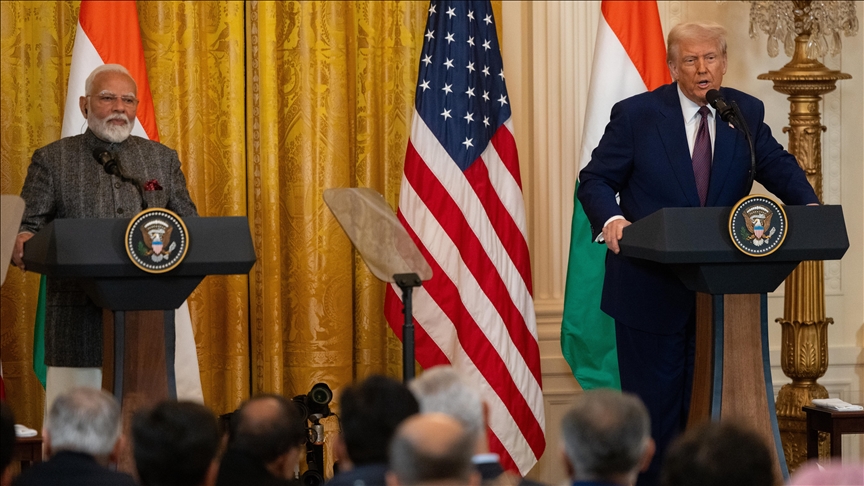Defense, trade, tech: Have Trump and Modi set course for deeper US-India ties?
US decision to boost defense ties and offer F-35s ‘is neither unexpected nor surprising’ as Trump ‘understands he has to keep India on the right side,’ says International Crisis Group’s Praveen Donthi

- US-India defense ties have been ‘largely rhetorical rather than substantive’ but Trump’s proposed arms sales could significantly enhance cooperation and their alliance to counter China, says Taiwan-based academic Chien-Yu Shih
- ‘Modi is handing over India’s huge market, energy needs, defense requirements, AI infrastructure to the US on a platter,’ says Indian analyst Pravin Sawhney
NEW DELHI
Last week, when Indian Prime Minister Narendra Modi became one of the first foreign leaders to hold summit-level talks with US President Donald Trump after his return to the White House, it underscored India’s strategic importance while also testing New Delhi’s long-standing alliances.
During the meeting, Trump was characteristically direct. He reiterated his demand for an end to the imbalance in the $130 billion worth of bilateral trade, and announced increased arms sales to India, a country that has historically relied on Washington’s rival Russia for military imports.
The US already gave India a pass by allowing it to acquire Russia’s S-400 air defense missile system, something for which it has sanctioned other allies due to concerns that its radar could compromise the stealth capabilities of American fighter jets.
India received its first S-400 squadron in December 2021, with additional deliveries expected by the end of 2025 and the final squadron scheduled for 2026. Despite initial warnings from Washington, India was granted a special waiver under the Countering America’s Adversaries Through Sanctions Act (CAATSA).
Now, Trump has declared that the US would supply New Delhi with F-35 fighter jets — a privilege typically extended only to NATO allies and close strategic partners.
“This is neither unexpected nor surprising,” Praveen Donthi, senior India analyst at the International Crisis Group, said in an interview with Anadolu.
“India has become more and more a partner in the US’ Indo-Pacific strategy,” he noted, recalling how Trump, during his first term, had “recruited” India into Washington’s broader geopolitical agenda in Asia.
Trump “understands he has to keep India on the right side” because it is “a huge market and one of the largest defense export destinations,” Donthi explained, emphasizing the role of the defense industry in shaping the US-India relationship.
However, he pointed out that while the US-India partnership has grown in recent years, a certain level of distrust still exists between the two countries.
Countering China
To deepen their strategic ties, Modi and Trump pledged to enhance cooperation across air, land, sea, space, and cyberspace. The leaders also announced the establishment of the Autonomous Systems Industry Alliance (ASIA) and initiated talks on a new 10-year defense pact.
The two leaders also discussed the India-Middle East-Europe Economic Corridor, with Trump outlining plans for a large-scale infrastructure project linking India, Israel, Italy, and the US through ports, railways, and undersea cables.
Another key focus was regional security, particularly in the Asia-Pacific, where both countries are working to counterbalance China’s military expansion.
“The US attempt to become actively involved in South Asia’s defense aligns with the needs of its Indo-Pacific strategy,” said Chien-Yu Shih, an associate research fellow at the Institute for National Defense and Security Research in Taiwan.
India is also a key player in the US-led Quadrilateral Security Dialogue (Quad), a strategic coalition that includes the US, Japan, and Australia, aimed at countering China’s growing influence.
“There hasn’t been much practical military cooperation. US-India defense ties have been largely rhetorical rather than substantive,” Chien-Yu observed.
However, he added that Trump’s proposed arms sales could significantly enhance the depth of cooperation, possibly even leading to a military alliance between the two nations.
“If the US can strengthen India's maritime surveillance and combat capabilities, it can also threaten China’s deployment in the Indian Ocean,” said Chien-Yu, referring to India’s Security and Growth for All in the Region (SAGAR) strategy.
“The waters around the Indian mainland were once considered India’s exclusive sphere of influence, but China’s Maritime Silk Road has changed that. Chinese-controlled dual-use ports now extend from Sri Lanka to the Maldives,” he added.
For Donthi, India’s border tensions with China are also shaping US-India relations, particularly in the defense sector.
The US has capitalized on the India-China border standoff to expand its defense sales, he noted, referring to Washington’s sale of drones and surveillance systems to India.
Tensions between India and China have remained high along the Line of Actual Control (LAC) — their disputed border in the Himalayas — since 2020.
Although there have been minor diplomatic improvements, Donthi pointed out that both sides continue to maintain forward troop deployments, incurring heavy economic costs.
During his visit, Modi reaffirmed that the US-India partnership promotes democracy, peace, and stability in the region. However, Donthi suggested that Western nations “prioritize economic interests over human rights concerns in India.”
“They see India as a massive market for business,” he said.
Nevertheless, he acknowledged that Indian diplomats have adeptly maintained strategic autonomy, balancing relationships with the US, Russia, and other global players.
“India remains equidistant from everyone while benefiting from everybody,” he added.
Weaning India away from Russia ‘not easy’
Trump’s strong pitch for increased defense collaboration with India has raised questions about how New Delhi will navigate its deep-rooted military ties with Moscow.
“The Russian-Indian relationship has developed over decades, with a tacit understanding of cooperation,” said Chien-Yu.
Currently, around 36% of India’s defense imports come from Russia.
To maintain its foothold in India’s defense market, Moscow has reportedly proposed producing its Sukhoi Su-57 stealth fighter jet in India.
While Trump is eager to draw India into the US defense fold, Donthi believes Washington will face significant challenges in breaking India’s reliance on Russia.
“The US will try its best to wean India away from the Russians, but it is not easy,” he said.
“There is a certain comfort and trust between India and Russia, while India is still distrustful of the US.”
Energy exports and trade deficit
In addition to defense and technology, energy cooperation emerged as a major theme during the Modi-Trump meeting, as Trump seeks to reduce the significant US trade deficit with India.
Trump has pushed for increased oil and gas exports to India, arguing that greater energy sales could help narrow the trade gap of over $45 billion.
Currently, the US is India’s fifth-largest crude oil supplier and the second-largest supplier of LNG after Qatar.
However, Russia remains India’s top energy provider, followed by Iraq, Saudi Arabia, the UAE, and the US.
In 2021, only 2% of India’s crude oil imports came from Russia, but that figure jumped to nearly 40% by 2023, largely due to discounted Russian oil following the Ukraine war.
While experts believe that increasing LNG imports from the US would be economically beneficial for India, crude oil shipments remain cost-prohibitive due to high transportation costs.
“With the US emerging as one of India’s largest trading partners, these developments will provide Indian exporters with new opportunities,” said Ashwani Kumar, president of the Federation of Indian Export Organizations.
Despite concerns about increased US market access, Kumar emphasized that cooperation in technology, defense, and green energy would enhance India’s global competitiveness.
Challenges persist
Despite the apparent bonhomie, some analysts question the balance of the outcomes of Modi’s Washington visit, while warning that certain existing issues could strain US-India ties going forward.
Pravin Sawhney, a former soldier and current editor of New Delhi-based strategic affairs magazine Force, said Modi’s trip seemed to be largely aimed at helping Trump achieve his "Make America Great Again" dream.
“Modi is handing over India’s huge market, energy needs, defense requirements, AI infrastructure to the US on a platter,” said Sawhney.
An Indian expert at a New Delhi-based trade research organization, who wished to remain anonymous, asserted that India “must make strategic decisions to allow US imports without compromising financial stability, including oil and other sectors where tariffs may be reduced.”
“The US aims to cut its trade deficit and negotiate aggressively on tariffs, pushing India to purchase more US goods,” said the expert.
“India needs to assess the impact sector by sector, especially where competition exists. Many US products complement India’s labor-intensive economy, which should reduce potential negative impacts. However, direct competition in some sectors may still pose challenges.”
Another area of friction could be the development of artificial intelligence (AI) technologies in the coming years.
Modi and Trump agreed to work on AI for solving societal challenges, while addressing protections and regulatory barriers, but that came just a day after India inked an AI governance pact in Paris along with 60 other countries and organizations – one that the US and UK refused to sign.
Concerns have also been raised in India over Trump’s deportation of undocumented Indian migrants, with more than 300 already sent back to the South Asian nation.
While Modi is facing domestic criticism, including from opposition parties, Donthi, the Crisis Group analyst, believes the issue would not have a major impact on ties with the US.
“It does not matter (to the Indian government) … Most of the diaspora (in the US) love Modi,” he said.
Trump won the elections on a pledge to send back undocumented migrants from all countries and Modi will not challenge him, he added.
Anadolu Agency website contains only a portion of the news stories offered to subscribers in the AA News Broadcasting System (HAS), and in summarized form. Please contact us for subscription options.







